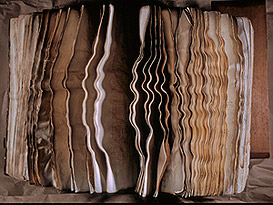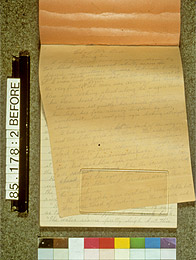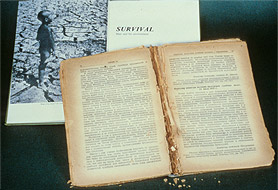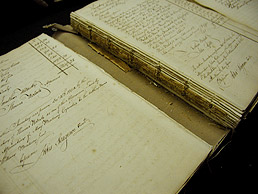
External Factors
1 Climate | 2 Light | 3 Pollutants |4 Storage and Handling
Previous sections discussed external factors such as temperature and humidity, light exposure, the presence of pollutants, and storage and handling practices. While these external agents affect all paper-based collections to a certain extent, some of them are particularly damaging to specific types of materials, which will be your focus here.
1 Climate
Temperature
Generally speaking, higher temperatures accelerate the chemical reactions that cause deterioration in paper-based collections. The rate of most chemical reactions doubles with an increase of 18 degrees F. Thus, cooler temperatures are preferred for collections with long-term value.
Temperature plays a particularly crucial role in the fading of chromogenic color photographs. The higher the temperature, the more movement there is on the molecular level, and the more likely it is that the molecules will be rearranged, resulting in dye fading. For this reason, cold storage is recommended for long-term preservation of color photographs.
Relative Humidity
|
|
Humidity (moisture in the air) provides water to fuel the chemical reactions that cause deterioration. The more moisture there is in the air, the more quickly chemical deterioration proceeds. Mold and many insects flourish in overly humid conditions. Mold causes staining and, in extreme cases, disintegration of paper, while insects can eat holes and cause permanent loss in paper-based collections.
High humidity is a primary factor in hydrolysis, which accelerates the deterioration of photographic prints in particular. Emulsion and binder layers soften, becoming sticky and sometimes difficult to handle. This is called ferrotyping, when the gelatin layer starts to swell, and prints may become stuck in frames and mounts. This can also accelerate the yellowing of albumen binders, and fading of dyes in color prints.
Parchment and other substrates are prone to rippling and bending in hot and humid conditions. But if humidity is too low, materials such as adhesives and leather bindings may become brittle and more susceptible to cracking, particularly during handling. Extended storage at low humidity can cause photographic emulsions to shrink and crack, supports to curl, and mounts to warp. Parchment may split and warp in overly dry conditions.
Fluctuating humidity levels also cause damage. Most materials expand and contract with small changes in relative humidity (RH). These changes weaken physical bonds and create stresses that can shorten the life of most materials. Always remember that temperature and relative humidity are interrelated. Given a specific amount of moisture in the air, relative humidity will decrease if the temperature increases. If the temperature falls, the relative humidity will rise.
2 Light
|
|
Light energy, in the form of waves, is absorbed by molecules within an object. This absorption of energy activates a variety of chemical reactions that have the potential to damage paper-based collections. This is termed photochemical deterioration.
Shorter wavelengths of light, such as UV light, have more energy than longer wavelengths. They bombard an object with more energy in a shorter time, causing photochemical deterioration to accelerate. This is why UV light is more damaging than visible light, although all light is damaging.
Practically speaking, light causes paper, bookbindings, and many media (such as inks and dyes) to fade, yellow, or discolor. Light exposure accelerates the oxidation of lignin, which causes paper to darken. Light also contributes to the weakening and embrittlement of paper fibers, textiles, and leather. Some types of light (incandescent lamps and direct natural light) also produce significant heat, accelerating the rate at which materials deteriorate.
Remember that the effects of light are cumulative and irreversible. Materials that are particularly sensitive to light include color photographic prints, early black and white images (especially salted paper and albumen prints), cyanotypes, blueprints, diazo prints, and hand-colored images.
3 Pollutants
|
|
Airborne contaminants in the form of gases and particulates jeopardize the preservation of collections.
For repositories in urban areas, gaseous pollution from sources such as industrial discharge, motor vehicle exhaust, and other combustion products can be a serious concern. Gaseous pollutants can also originate indoors, given off by common substances such as paint, cleaning supplies, untreated wood, photocopiers, and certain kinds of adhesives and plastics. Various types of gaseous pollutants initiate chemical reactions that contribute to the deterioration of paper-based collections. These reactions are usually worsened when high relative humidity is also present.
Particulates come in the form of tiny solids—grit, grime, smoke, dust—which originate largely from industrial processes, vehicle engines, wood-and coal-fired heating systems, smoking, and cooking. They are generally abrasive and acidic and often highly reactive chemically.
Photographs in particular are extremely sensitive to atmospheric pollutants. Particulate pollutants may cause abrasion of emulsions and attract mold or insects. Gaseous pollutants such as sulphur dioxide, nitrogen oxides, ozone, and formaldehyde contribute to sulfiding, redox reactions, and dye discoloration.
4 Storage and Handling
|
|
As discussed in Session 3: Caring for Collections, poor storage and handling can also cause physical and chemical damage to collections.
Physical damage due to poor storage and/or handling might include tears, creases, dog-eared corners, scratches or abrasions, or damage to book bindings. In some cases disfiguring marks may be made on items (e.g., vandalism or writing on the back of photographs that either bleeds through or creates indentations). Staples and paper clips can stain and deform paper documents.
Chemical damage due to poor storage and/or handling might include staining due to acid migration from acidic storage enclosures or adjacent materials such as news clippings or bookmarks.
Humidity (moisture in the air) provides water to fuel the chemical reactions that cause deterioration. The more moisture there is in the air, the more quickly chemical deterioration proceeds. Mold and many insects flourish in overly humid conditions. Mold causes staining and, in extreme cases, disintegration of paper, while insects can eat holes and cause permanent loss in paper-based collections.
High humidity is a primary factor in hydrolysis, which accelerates the deterioration of photographic prints in particular. Emulsion and binder layers soften, becoming sticky and sometimes difficult to handle. This is called ferrotyping, when the gelatin layer starts to swell, and prints may become stuck in frames and mounts. This can also accelerate the yellowing of albumen binders, and fading of dyes in color prints.
Parchment and other substrates are prone to rippling and bending in hot and humid conditions. But if humidity is too low, materials such as adhesives and leather bindings may become brittle and more susceptible to cracking, particularly during handling. Extended storage at low humidity can cause photographic emulsions to shrink and crack, supports to curl, and mounts to warp. Parchment may split and warp in overly dry conditions.
Fluctuating humidity levels also cause damage. Most materials expand and contract with small changes in relative humidity (RH). These changes weaken physical bonds and create stresses that can shorten the life of most materials. Always remember that temperature and relative humidity are interrelated. Given a specific amount of moisture in the air, relative humidity will decrease if the temperature increases. If the temperature falls, the relative humidity will rise.




